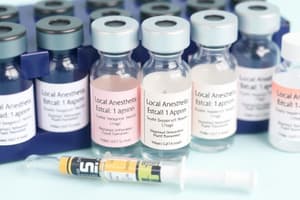Podcast
Questions and Answers
What is the maximum dose of lidocaine with epinephrine that can be administered to an adult?
What is the maximum dose of lidocaine with epinephrine that can be administered to an adult?
- 300 mg
- 500 mg (correct)
- 400 mg
- 200 mg
Which local anesthetic has the longest duration of action when used alone?
Which local anesthetic has the longest duration of action when used alone?
- Lidocaine
- Bupivacaine (correct)
- Procaine
- Mepivacaine
A physician needs to perform a minor surgery with an expected duration of 3 hours. Which local anesthetic with epinephrine would be the MOST appropriate choice?
A physician needs to perform a minor surgery with an expected duration of 3 hours. Which local anesthetic with epinephrine would be the MOST appropriate choice?
- Bupivacaine
- Lidocaine (correct)
- Mepivacaine
- Procaine
Which of the following best describes the onset of action of Bupivacaine?
Which of the following best describes the onset of action of Bupivacaine?
Why are ester injectables used less frequently than amide injectables?
Why are ester injectables used less frequently than amide injectables?
What is the primary purpose of wet-to-dry dressings?
What is the primary purpose of wet-to-dry dressings?
Which phase of wound healing involves the migration of myofibroblasts into the wound?
Which phase of wound healing involves the migration of myofibroblasts into the wound?
Which of the following local anesthetics is commonly used in a topical form for skin and mucous membranes?
Which of the following local anesthetics is commonly used in a topical form for skin and mucous membranes?
During which phase of wound healing do macrophages remove necrotic tissue?
During which phase of wound healing do macrophages remove necrotic tissue?
What concentration of lidocaine is typically used for children?
What concentration of lidocaine is typically used for children?
How long before removal should dressings for open wounds be timed?
How long before removal should dressings for open wounds be timed?
Which of the following situations would warrant the use of Procaine or Tetracaine?
Which of the following situations would warrant the use of Procaine or Tetracaine?
Why should caution be exercised when operating on lower extremities of patients with Diabetes Mellitus?
Why should caution be exercised when operating on lower extremities of patients with Diabetes Mellitus?
In the context of potential interference with wound closure, what condition does jaundice indicate?
In the context of potential interference with wound closure, what condition does jaundice indicate?
What is the primary concern when operating in areas with superficial vasculature and nerves?
What is the primary concern when operating in areas with superficial vasculature and nerves?
Why is it recommended to delay surgery for 7-10 days when a patient is taking aspirin?
Why is it recommended to delay surgery for 7-10 days when a patient is taking aspirin?
What is the primary function of chemical mediators released from injured tissue during the coagulation phase?
What is the primary function of chemical mediators released from injured tissue during the coagulation phase?
What is a contraindication for performing cryosurgery?
What is a contraindication for performing cryosurgery?
During what phase of wound healing does the scar tissue attain up to 90% strength of the original tissue?
During what phase of wound healing does the scar tissue attain up to 90% strength of the original tissue?
What is the primary risk of operating on areas with impaired blood circulation?
What is the primary risk of operating on areas with impaired blood circulation?
Which deficiency has the greatest effect on interfering with wound closure?
Which deficiency has the greatest effect on interfering with wound closure?
Why should flammable agents like alcohol be avoided when using electrocautery or hyfrecation?
Why should flammable agents like alcohol be avoided when using electrocautery or hyfrecation?
What could be a consequence of excessive suture tension in a surgical wound?
What could be a consequence of excessive suture tension in a surgical wound?
When is toe-nail removal contraindicated?
When is toe-nail removal contraindicated?
During a digital nerve block procedure, after redirecting the needle towards the palmar nerve, where should the injection be administered?
During a digital nerve block procedure, after redirecting the needle towards the palmar nerve, where should the injection be administered?
Which systemic adverse effect is NOT associated with anesthetic overdose or intravenous administration?
Which systemic adverse effect is NOT associated with anesthetic overdose or intravenous administration?
Why is epinephrine added to local anesthetics?
Why is epinephrine added to local anesthetics?
Which of the following is a contraindication for using epinephrine in conjunction with a local anesthetic?
Which of the following is a contraindication for using epinephrine in conjunction with a local anesthetic?
What concentration of epinephrine should be added to 10 mL of anesthetic?
What concentration of epinephrine should be added to 10 mL of anesthetic?
What is TRUE regarding cryosurgery using liquid nitrogen?
What is TRUE regarding cryosurgery using liquid nitrogen?
During cryosurgery, when using a cotton tip applicator to apply liquid nitrogen, what is the next step after applying the liquid nitrogen onto the lesion?
During cryosurgery, when using a cotton tip applicator to apply liquid nitrogen, what is the next step after applying the liquid nitrogen onto the lesion?
For which type of lesion are cryoprobes frequently used in cryosurgery?
For which type of lesion are cryoprobes frequently used in cryosurgery?
What is the primary characteristic of an open drain?
What is the primary characteristic of an open drain?
Generally, when should dressings be removed post-operatively?
Generally, when should dressings be removed post-operatively?
Which suture size represents the thickest diameter?
Which suture size represents the thickest diameter?
For a patient with delayed healing due to corticosteroid usage, when should sutures typically be removed?
For a patient with delayed healing due to corticosteroid usage, when should sutures typically be removed?
What suture size is typically used for superficial non-absorbable sutures on the face?
What suture size is typically used for superficial non-absorbable sutures on the face?
Post-operatively, a patient exhibits angioedema, urticaria, and hypotension. What immediate treatment should be initiated?
Post-operatively, a patient exhibits angioedema, urticaria, and hypotension. What immediate treatment should be initiated?
What is the primary treatment for 'dog ears' that develop post-operatively?
What is the primary treatment for 'dog ears' that develop post-operatively?
When should sutures be removed from the ear or eyelid?
When should sutures be removed from the ear or eyelid?
Which degree of hemorrhoids is appropriately treated with band & ligation?
Which degree of hemorrhoids is appropriately treated with band & ligation?
A patient presents with a purulent infection at the distal pad of their finger. Which of the following is the most appropriate procedure?
A patient presents with a purulent infection at the distal pad of their finger. Which of the following is the most appropriate procedure?
What is the recommended procedure for a keratoacanthoma?
What is the recommended procedure for a keratoacanthoma?
What is the etiology of Lichen Planus?
What is the etiology of Lichen Planus?
Which of the following best describes a lipoma?
Which of the following best describes a lipoma?
A patient has milia on their face. Which of the following is the most appropriate treatment option?
A patient has milia on their face. Which of the following is the most appropriate treatment option?
Which of the following is the most appropriate treatment for molluscum contagiosum?
Which of the following is the most appropriate treatment for molluscum contagiosum?
What is the recommended procedure for a Nevi?
What is the recommended procedure for a Nevi?
Flashcards
Wet-to-Dry Dressing
Wet-to-Dry Dressing
A type of wound dressing used for wounds with necrotic debris. It involves applying a moist dressing that is removed after a period of time, typically 48 hours, to remove debris and promote healing.
Wet-to-Wet Dressing
Wet-to-Wet Dressing
A dressing that keeps the wound moist, promoting epithelialization and wound closure. It is typically applied after a wet-to-dry dressing.
Coagulation Phase
Coagulation Phase
The first stage of wound healing, where blood clots form to stop bleeding. This involves vasoconstriction, fibrin formation, and platelet aggregation.
Inflammation Phase
Inflammation Phase
Signup and view all the flashcards
Proliferation Phase
Proliferation Phase
Signup and view all the flashcards
Remodeling Phase
Remodeling Phase
Signup and view all the flashcards
Interference with Wound Closure
Interference with Wound Closure
Signup and view all the flashcards
Diabetes
Diabetes
Signup and view all the flashcards
Minor surgery in lower extremities
Minor surgery in lower extremities
Signup and view all the flashcards
Areas with superficial vasculature and nerves
Areas with superficial vasculature and nerves
Signup and view all the flashcards
Corticosteroids and surgery
Corticosteroids and surgery
Signup and view all the flashcards
Anticoagulants and surgery
Anticoagulants and surgery
Signup and view all the flashcards
Aspirin and surgery
Aspirin and surgery
Signup and view all the flashcards
Bleeding disorders and surgery
Bleeding disorders and surgery
Signup and view all the flashcards
Cryosurgery contraindications
Cryosurgery contraindications
Signup and view all the flashcards
Electrocautery and Hyfrecation precautions
Electrocautery and Hyfrecation precautions
Signup and view all the flashcards
What is Lidocaine?
What is Lidocaine?
Signup and view all the flashcards
What are the maximum doses of Lidocaine?
What are the maximum doses of Lidocaine?
Signup and view all the flashcards
What is Mepivacaine?
What is Mepivacaine?
Signup and view all the flashcards
What is Bupivacaine?
What is Bupivacaine?
Signup and view all the flashcards
What are ester anesthetics?
What are ester anesthetics?
Signup and view all the flashcards
What is Procaine?
What is Procaine?
Signup and view all the flashcards
What is Tetracaine?
What is Tetracaine?
Signup and view all the flashcards
What is Benzocaine?
What is Benzocaine?
Signup and view all the flashcards
Nerve block
Nerve block
Signup and view all the flashcards
Local infiltration
Local infiltration
Signup and view all the flashcards
Epinephrine
Epinephrine
Signup and view all the flashcards
Systemic toxicity
Systemic toxicity
Signup and view all the flashcards
Vasovagal syncope
Vasovagal syncope
Signup and view all the flashcards
Allergic reaction
Allergic reaction
Signup and view all the flashcards
Cryosurgery
Cryosurgery
Signup and view all the flashcards
Cryoprobe
Cryoprobe
Signup and view all the flashcards
Open Drain
Open Drain
Signup and view all the flashcards
Penrose Drain
Penrose Drain
Signup and view all the flashcards
Suture Removal
Suture Removal
Signup and view all the flashcards
Suture Sizes
Suture Sizes
Signup and view all the flashcards
Anaphylaxis
Anaphylaxis
Signup and view all the flashcards
Dog Ears
Dog Ears
Signup and view all the flashcards
Edema
Edema
Signup and view all the flashcards
Hernia
Hernia
Signup and view all the flashcards
Hemorrhoids
Hemorrhoids
Signup and view all the flashcards
Felon
Felon
Signup and view all the flashcards
Keratoacanthoma
Keratoacanthoma
Signup and view all the flashcards
Lipoma
Lipoma
Signup and view all the flashcards
Milia
Milia
Signup and view all the flashcards
Lichen Planus
Lichen Planus
Signup and view all the flashcards
Pyogenic Granuloma
Pyogenic Granuloma
Signup and view all the flashcards
Paronychia
Paronychia
Signup and view all the flashcards
Study Notes
Pre-Operative Precautions
-
General considerations
- Patients taking corticosteroids (immunosuppressants) are at higher risk of post-operative infection
- Patients taking anticoagulants or antiplatelets (blood thinners) may be at higher risk of hemorrhaging. Aspirin should be discontinued 7-10 days before surgery to reduce effects on platelet aggregation
- Patients with bleeding disorders or coagulopathies
- Patients with high levels of cryoglobulins, cold urticaria, or Raynaud's disease should not undergo surgery on areas with impaired circulation
-
Cryosurgery
- Avoid areas at risk for hair loss
- Patients with significant risk factors like high levels of cryoglobulins, cold urticaria, or Raynaud's disease should not undergo surgery on those areas
-
Electrocautery & Hyfrecation -Avoid flammable agents for disinfection -Caution when working with patients with metal implants, IUDs, metal dentures, or prosthetics, and patients should remove all jewelry
-
Suturing
- Avoid suture tension during wound closure, as it may cause skin edge ischemia. -Insert the suturing needle perpendicular (90°) to the skin plane to evert skin edges
- Do not suture wounds with contamination (ex. puncture or bite wounds, wounds with discharge)
Wound Care
- Before wound closure
- Hemostasis is essential prior to any cleaning or wound closure attempt
- During wound closure
- Primary closure: used for wounds with minimal contamination, involves approximating and closing the skin edges (suturing)
- Secondary closure: used for wounds with higher risk of contamination or infection, the wound is left open, allowing healing by epithelialization and wound contraction
- Delayed primary closure: heavily contaminated wounds that no longer have residual contamination may be closed directly through primary closure methods.
- After wound closure
- Dressings -Sutured wounds require dressings to absorb drainage and provide moisture support for epithelialization -Open wounds require dressings to maintain moisture for healing process
- Interference with wound closure -Factors influencing wound healing such as malnutrition, diabetes, jaundice, uremia, medications or chemotherapy
Equipment
- Biopsy punch
- Instrument used for taking tissue samples from a lesion to study it
- Diameter selected to allow sampling of area surrounding lesion
- Cryogens -Liquid nitrogen (most common, rapid and deep destruction) -Carbon dioxide (dry ice, poor tissue destruction)
- Curette
- Scraping tool used for superficial and partial-thickness tissue lesions
- Electrocautery -Electrical current tool used to destroy tissues and coagulate blood vessels
- Chemical cautery
- Chemical agents that destroy tissues (ex. phenol, silver nitrate, salicylic acid, etc)
Operative Procedures
- Anesthesia
- Selection and use of different anesthetic types
- Monitoring adverse effects such as allergic reaction, cardiovascular reactions, central nervous system reactions, vasovagal reactions
- Other operative procedures
- Detailed steps for specific procedures such as those involving different lesions
Post-Operative Procedures
- Dressings -Purpose: - Absorption of exudates to prevent fluid loss -Aiding in debridement of necrotic tissues -Providing hemostasis (stopping bleeding) -Pain relief -Wound protection and support
- Removal -Usually removed after 48 hours or as clinically warranted.
Post-Operative Complications
- Detailed descriptions of various complications from surgical procedures, categorized by symptoms.
Operative Procedures by Lesion
- Descriptions of procedures to treat different kinds of lesions. Each lesion type has a distinct description and suggested treatment method.
Injecting an Anesthetic
- Local techniques (direct infiltration, field block) detailed explanations of methods
- Regional techniques (nerve blocks)
Adverse Effects to Monitor
- Potential adverse effects patients may experience from surgical procedure
Adding Epinephrine
- Rationale for use, indications, and/or contraindications
Step-by-Step Instructions for Various Procedures
- Explicit guidance for each of the types of procedures mentioned in the text (excision, removal, cryo, electrosurgery, etc).
Excision and Removal
- Step by step procedure to remove a lesion.
- Specifics of how to prepare, such as using a clean field or disinfectant
Incision and Drainage
- Step-by-step instruction to perform this procedure, using sterile procedures and appropriate tools
Suturing
- Description of various suturing techniques (interrupted, buried, horizontal mattress, vertical mattress, running/continuous)
- Advantages and disadvantages of each technique
- Specifics for each suture type (synthetic, natural)
- Conditions where sutures (or adhesives) are contraindicated.
Alternatives to Suturing
- Description of use of adhesives (ex. cyanoacrylate glue) as alternatives to sutures
- Types and functions of adhesives in surgical repair
- Advantages and disadvantages of using adhesives over sutures.
Additional information (Page 19)
- Information on post-operative complications, various lesions (by type), and further detailed information on operative procedures
Studying That Suits You
Use AI to generate personalized quizzes and flashcards to suit your learning preferences.




